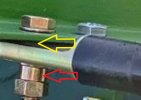In the RC2000's user manual, Research Concept suggests to connect the ground wire only to the controller pin but not to the motor ground. It must be leaved opened at the motor side. So, only one cap of the cable must be connected. Doing this, the cable is shielded but possible ground loops are avoided.
OH DEAR, OH DEAR, "the old, old wives' tale" of leaving one end of the shield of a shielded cable unconnected to avoid ground loops!!!!

Having worked for quite a long time in the industrial and defence sectors in EMC control (as well as electrical/electronic safety control!), I can tell you that doing this this is VERY much depricated because it leaves the sensing circuits in the motor/actuator "floating" and likely to pick up/radiate any interference that's around - including that on the motor cable cores!
As an example of something very similar, in my last job, I was given a long sensor probe to get EMC certified (for CE Marking purposes) but the first time I tested it in a screened the bloody thing spewed RF right across the spectrum and I had to abort the testing very quickly.
Investication uncovered that the cable was in 3 sections:
- 2 lengths of heavily screened cable, one of which connected to the probe
- a short intermediate section consisting of a plastic box and small circuit board, the ground connections to which were virtually non-existent, and absolutely no use for EM control because that also meant the probe cable screen and probe were effectively ungrounded for for EMC purposes.
Long story cut short: replaced the plastic box by a metal one with proper 360 deg metal cable glands at either end to ensure the circuit board was screened and that the screen was contiguous throughout the length of the probe cable, and also improved the continuity of the cable connections to the exterior control box and the probe.
Result: the modified probe sailed through the relevant industrial level RF emissions, immunity and surge tests pretty much first time.
(and that did my status as a pretty new contractor absolutely no harm at all - I finally stayed there for nearly 3 yrs and fixed quite a few other EMC issues along the way  !).
!).
Thus, grounding the shield at BOTH the RX and motor/actuator ends ensures that any such interference doesn't get onto the sensing cores due to the "skin effect" phenomena which restricts it to the outer skin of the shield, and then to the chassis of the Rx and thus to the outer skin of a Faraday cage - thus the interference doesn't get into the internally located sensing circuits at either end.







